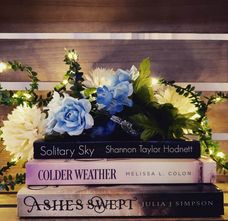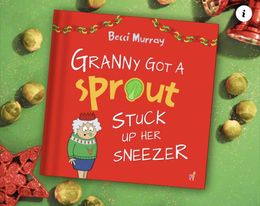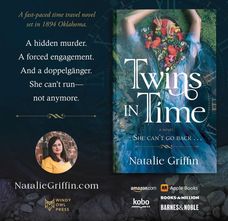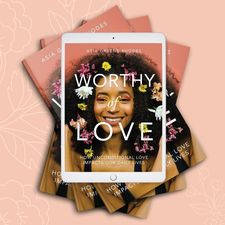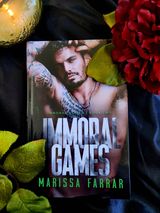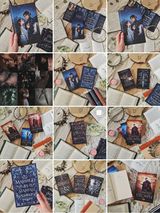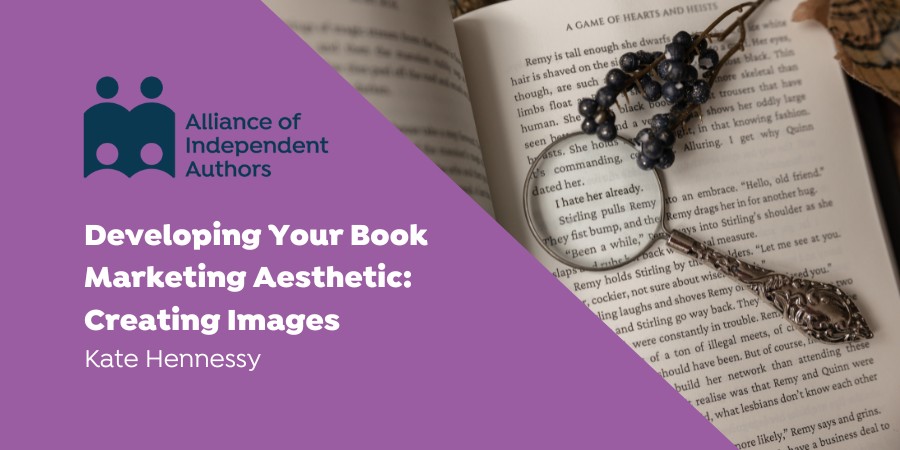As indie authors, seeing your book in the wild in a reader’s hand is a wonderful moment. Made even more special if you're lucky enough to be tagged in stunning photos on Instagram or TikTok or any social media platforms. But how do you do it? Today, the Alliance of Independent Authors AskALLi team welcomes Kate Hennessy, professional photographer and author to explain how to create your own book marketing aesthetic as well as how to create images.
What Do We Mean Book Marketing Aesthetic?
We know there are different opinions on the meaning of aesthetic, but today, we're using the term book marketing aesthetic to mean: your unique combination of branding, identity and images that create an irresistible look and feel for your author brand, books, and series. The styles and themes of your aesthetic are managed across your website, logos, brochures and promotion campaigns, to convey certain meanings and experiences to your readers. They give a particular feel and vibe. We're going to be looking at how to create that look and feel with top tips from Kate Hennessy.
Why Create a Book Marketing Aesthetic?

Kate Hennessy
Kate's upcoming book release
Kate Hennessy is an award-winning, internationally published photographer and videographer. She works with other creatives to craft stand-out images and video content to take their business branding and marketing to the next level. She has photographed best-selling authors, award-winning performers, and British royalty, but especially loves working with small business owners, families, and anyone who loves musicals. Her debut, sapphic, dystopian novel, Watch Over Me, will be out later in 2023.
Find out more on her website and Instagram.
We've all been captivated by mesmerising, scroll-stopping social media posts that showcase the latest book releases or recommend must-reads. These stunning book marketing aesthetics, whether they feature a beautifully curated bookshelf, a stunning cover design, or a creative book trailer, have a way of enticing and exciting us in our passion for reading.
It's no secret that social media has become a powerful tool for book marketing, and with the right content, authors can elevate their online strategy. In our fast-paced digital world, it’s crucial to grab your audience's attention quickly by standing out from the crowd. By using photography and videography to communicate the genre, theme, and tone of your book, you too can create a visually compelling experience that draws in potential readers and encourages them to take action towards buying your book.
In much the same way as your cover design needs to attract the right readers, photos and videos of your book can also influence how readers perceive the content. As a flavour of what they can expect when they pick up your book, the right imagery will resonate with the people who’ll most love your writing.
But let's face it, creating professional-looking photo and video content can be challenging, especially for those who feel digital marketing isn’t their strength. With new trends and platforms constantly emerging, it can be tough to keep up.
Connection Not Perfection
The beauty of social media, particularly newer platforms such as TikTok, is that the goal isn’t perfection, it’s connection.
Although written content remains an essential component of effective marketing, studies have shown that our brains process visuals much faster, which means photos and video can lead to higher engagement and conversions. And this makes the camera on your phone your secret weapon in driving book sales.
In this blog post, you’ll find out how to make the most of your phone's camera to create eye-catching content that features your book to attract the right readers. Whilst showing up personally on your socials can help faster foster connection and growth, this kind of content doesn’t require you to show your face and gives introverts and social media ambivalent authors a shot, so to speak.
Whether you're a seasoned author or just starting out, why not try these tips and tricks for using basic phone photography and videography to create a consistent and engaging aesthetic for your book? So, grab your phone and your book, and let's get started!
Book Marketing Aesthetic: Picture Perfect
When capturing images of your book and creating book marketing visuals, there are some key things to keep in mind.
Use natural light:
For the best quality images when taking photos with a phone, use natural light during the day. Try positioning your book near a window. By experimenting with rotation and distance, aim for a subtle range of gentle highlights and soft shadows, as these create interesting depth and texture. The goal, in most cases, is to avoid under or overexposing all or parts of the image, which look harsh and unattractive. This is best achieved by avoiding artificial lighting and flash.
Consider the background:
The easiest option is to clear a surface at home for a simple background that won't distract from your book, such as a worktop, table, floor, a product photography photo-board, or even your choice of wrapping paper! Just setting your book on the arm of your sofa or bedside table can evoke a familiar sense of place where people usually enjoy reading. Add a plant or cup of tea, and you’ve got yourself an Instagramable lifestyle picture. Different angles can provide multiple pieces of content.
Setting sells:
You can step this up a notch by seeking inspiration from your book’s settings, themes, scenes, and readership. As with marketing any product, your book is selling particular feelings. That’s why we all have our favourite genres—the ones which thrill or motivate or comfort or amuse. If your images can recreate these feelings, then the aesthetic will attract the readers most likely to enjoy your book. Think travel books on beaches, fantasy in woodlands, cookbooks in the kitchen, and romance in a cosy cafe. Obvious but evocative.
Portrait mode, if you have it in your settings, is often a good choice on location as it subtly blurs the background to make your book pop for a more professional finish. Wide angle can be fun too if you want to deliberately distort your book for dramatic effect. Try everything your camera settings have to offer to find a creative style that fits with your book.
Aim for unique:
For truly standout imagery, try collecting relevant props to visually represent your book. Whatever your genre, gather small items that relate to the content, such as trinkets, containers, flowers, artefacts, maps, shells, stationery, cooking utensils, food, or fabrics. The key here is to layer the image to add intrigue by way of props, textures, and colours. Even relevant bookmarks are a fun prop that speak volumes! Remember, your book is the star, so start with that and build around it slowly, experimenting with composition, levels, and balance.
This process takes time, so don’t be afraid to play around with setups and angles to find the best ways to showcase your book. You can take photos from directly overhead, from the side, pulled back or close-up, in vertical, square, or landscape crops, and using different modes on your phone’s camera to create a variety of effects. Don’t forget, the back and the inside of your book can make great imagery, too!
Create a suite of media:
You might be surprised by how quickly your bank of images builds because you can create multiple photos from just one setup with different angles and a few choice prop moves.
But before you take a single shot, first consider where exactly you’re going to use these images, as this will dictate how you shoot. Social media platforms require different crops and orientations, and there will likely be settings on your phone’s camera to change the dimensions. Shoot with intention so you make full use of viewers’ screens. For most social media platforms, vertical is often a good choice because it will fill the screen and therefore maximise the viewers’ experience and your marketing space, but be sure to scroll your platform of choice and look for which crops and orientations are most common.
Edit your photos: After taking your images, you might like to use a photo editing app, such as Lightroom Mobile or Photoleap to adjust brightness, contrast, and saturation to make your photos look more polished. This step isn’t obligatory, especially if you’ve taken time to create a great photo in the first place, but it can be fun to stretch your artistry and enhance the feel of an image. Go easy with filters, only use them if they truly match the tone of your setup and book. You don’t want to lose your efforts with lighting and colours with a heavy-handed filter.
To get especially creative, you can try experimenting with apps that use A.I. or add motion to your still images. Apps like Motionleap can animate elements of your photo to create cinemagraphs, which bridge an exciting gap between photography and videography.
Emote with video: Whilst you’re creating a library of images, it’s worth also capturing some short video clips. You can either use these as stand-alone clips for social media posts or stitch them together to form mini trailers in apps such as CapCut.
Short-form video is essential in current marketing trends, particularly on social media. A 15-60 second video can quickly engage your audience. Like the first line of your book, treat the first three seconds as the hook, using anything that speaks to your ideal reader. With both photos and video, you can add royalty-free music, text, or voiceover to help capture and hold their attention. Just make sure you add a call to action at the end that encourages viewers to take the next step in finding out more.
To go further, or avoid shooting altogether, you can even use Canva or else source stock footage to string together a short trailer.
When all else fails:
Sometimes, despite our best efforts, our endeavours can fall short of our hopes. Never fear, there are other options to produce scroll-stopping imagery of your book.
You can source ready-made photo templates where you just paste a JPEG or PNG image of your book cover into an existing setup.
Otherwise, for a bespoke service, you can hire a professional photographer, and there are options for most budgets, so don’t be afraid to outsource help. Imagery is designed to help you promote and sell your book, so it’s a worthwhile investment for both your online and print marketing materials, helping to set the stage.
Book Marketing Asethetic: A Creative Case Study
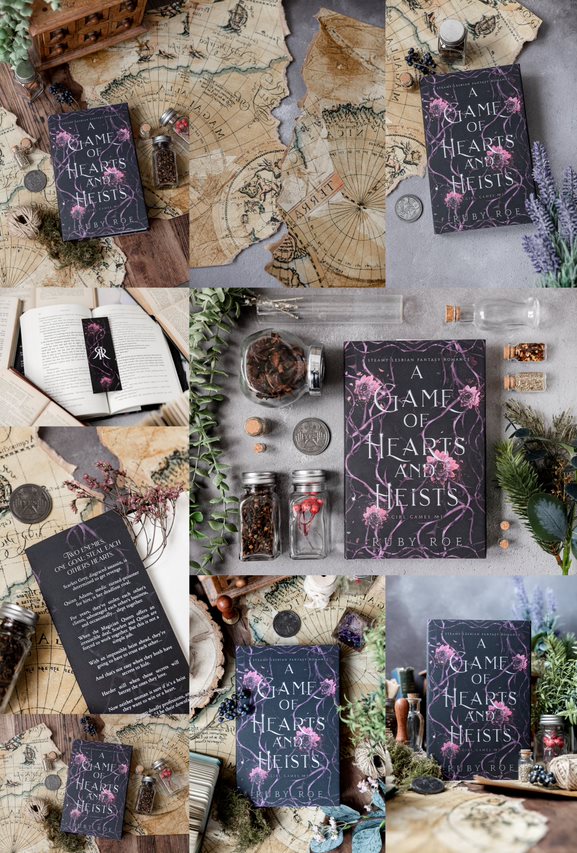
Images by Kate Hennessy Photography
Working with a professional photographer is an equally exciting option and can be a smart move if you don’t want to create your own images.
This selection of photos was created for author, Ruby Roe, for her debut novel, A Game of Hearts & Heists, a sapphic romance set within a dramatic fantasy adventure.
The images were crafted for use primarily on social media with a selection of landscape and vertical crops for maximum flexibility. Drawing on the novel’s setting and themes, the DIY props were crafted from common items, widely purchased.
They were shot with a DSLR camera on a 60x60cm product photo-board with natural window light from the left.
All images can be repeatedly repurposed with different text (quotations, POV, trope information, etc.), voiceover, and music. They’re also handy for website, print marketing, and press release usage.
Images by Kate Hennessy Photography
A Picture Tells A Thousand Words Invites A Thousand Readers
Think about an image as a wordless blurb. But if words are your everything, try compiling a simple, descriptive list, e.g., dark, magical, bold, nostalgic, romantic, futuristic, practical, flavoursome, etc. Use these words to guide every choice you make with your aesthetic online. Not only will this strengthen your images, but it’ll also strengthen your whole brand.
In conclusion, creating a strong visual identity for your book is essential in today's highly visual online landscape. As readers increasingly rely on social media and other online platforms to discover, search for, and engage with books, authors must prioritise creating eye-catching and memorable imagery to promote their writing.
By utilising photography and videography, you can capture the essence of your book and connect with potential readers. By taking the time to experiment with lighting, angles, and setups, and by using descriptive words to guide your aesthetic choices, you can create a brand identity that not only promotes your book but also establishes you as a serious, professional author.
In a world where attention is a precious commodity, the power of striking visuals can make all the difference in capturing the hearts and minds of your readers. So don't underestimate the impact of a well-crafted photo or video of your book. After all, marketing your book is all about the exposure, right?
ALLi Member Gallery

